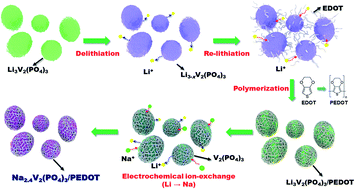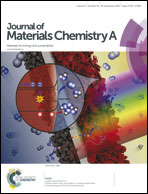Unexpectedly high electrochemical performances of a monoclinic Na2.4V2(PO4)3/conductive polymer composite for Na-ion batteries†
Abstract
We report a monoclinic Na2.4V2(PO4)3/poly(3,4-ethylenedioxythiophene) (M-NVP/PEDOT) composite as a novel cathode material for sodium-ion batteries. The active materials were homogenously encapsulated by thin layers of the electro-conductive polymer PEDOT, and X-ray diffraction analysis indicated that the final products were crystallized into a monoclinic structure. The composite exhibited much more outstanding power capability and cyclability than pristine M-NVP. The discharge capacity of the M-NVP/PEDOT electrode was maintained up to ∼109.8 mA h g−1 at 10C (1C = ∼178 mA g−1), which was ∼9 times higher than that of pristine M-NVP under the same conditions. Moreover, whereas severe capacity degradation was observed for pristine M-NVP, the M-NVP/PEDOT composite delivered ∼81% capacity retention compared with the initial capacity over ∼500 cycles at 1C. In particular, the available capacity of M-NVP/PEDOT was ∼143.3 mA h g−1, corresponding to ∼2.4 mol Na+ (de)intercalation, which is larger than the reversible capacity of rhombohedral Na3V2(PO4)3, at which only 2 mol Na+ can be (de)intercalated. This unexpectedly high capacity of the M-NVP/PEDOT composite was clearly confirmed through combined studies using several experiments and first-principles calculation.



 Please wait while we load your content...
Please wait while we load your content...